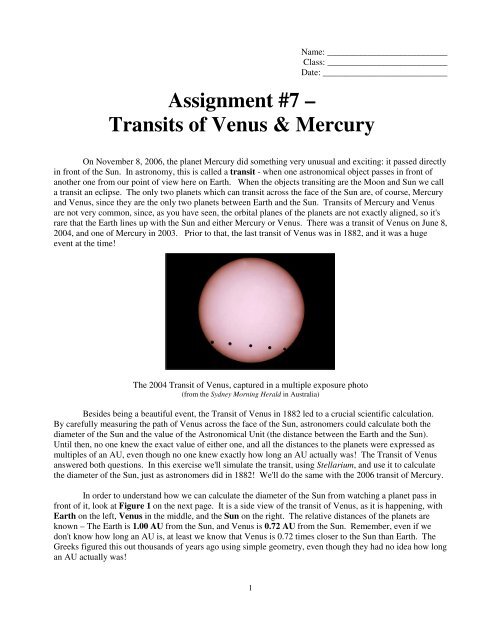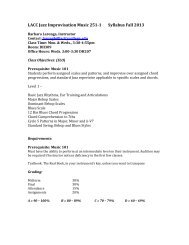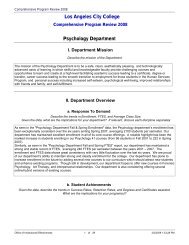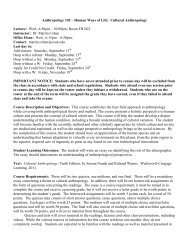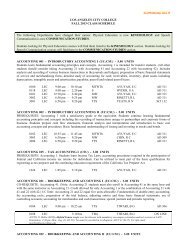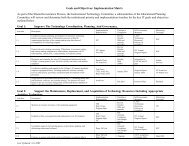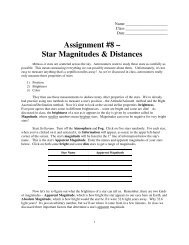Assignment #7 – Transits of Venus & Mercury - Faculty Web Pages
Assignment #7 – Transits of Venus & Mercury - Faculty Web Pages
Assignment #7 – Transits of Venus & Mercury - Faculty Web Pages
You also want an ePaper? Increase the reach of your titles
YUMPU automatically turns print PDFs into web optimized ePapers that Google loves.
1<br />
Name: ___________________________<br />
Class: ___________________________<br />
Date: ____________________________<br />
<strong>Assignment</strong> <strong>#7</strong> <strong>–</strong><br />
<strong>Transits</strong> <strong>of</strong> <strong>Venus</strong> & <strong>Mercury</strong><br />
On November 8, 2006, the planet <strong>Mercury</strong> did something very unusual and exciting: it passed directly<br />
in front <strong>of</strong> the Sun. In astronomy, this is called a transit - when one astronomical object passes in front <strong>of</strong><br />
another one from our point <strong>of</strong> view here on Earth. When the objects transiting are the Moon and Sun we call<br />
a transit an eclipse. The only two planets which can transit across the face <strong>of</strong> the Sun are, <strong>of</strong> course, <strong>Mercury</strong><br />
and <strong>Venus</strong>, since they are the only two planets between Earth and the Sun. <strong>Transits</strong> <strong>of</strong> <strong>Mercury</strong> and <strong>Venus</strong><br />
are not very common, since, as you have seen, the orbital planes <strong>of</strong> the planets are not exactly aligned, so it's<br />
rare that the Earth lines up with the Sun and either <strong>Mercury</strong> or <strong>Venus</strong>. There was a transit <strong>of</strong> <strong>Venus</strong> on June 8,<br />
2004, and one <strong>of</strong> <strong>Mercury</strong> in 2003. Prior to that, the last transit <strong>of</strong> <strong>Venus</strong> was in 1882, and it was a huge<br />
event at the time!<br />
The 2004 Transit <strong>of</strong> <strong>Venus</strong>, captured in a multiple exposure photo<br />
(from the Sydney Morning Herald in Australia)<br />
Besides being a beautiful event, the Transit <strong>of</strong> <strong>Venus</strong> in 1882 led to a crucial scientific calculation.<br />
By carefully measuring the path <strong>of</strong> <strong>Venus</strong> across the face <strong>of</strong> the Sun, astronomers could calculate both the<br />
diameter <strong>of</strong> the Sun and the value <strong>of</strong> the Astronomical Unit (the distance between the Earth and the Sun).<br />
Until then, no one knew the exact value <strong>of</strong> either one, and all the distances to the planets were expressed as<br />
multiples <strong>of</strong> an AU, even though no one knew exactly how long an AU actually was! The Transit <strong>of</strong> <strong>Venus</strong><br />
answered both questions. In this exercise we'll simulate the transit, using Stellarium, and use it to calculate<br />
the diameter <strong>of</strong> the Sun, just as astronomers did in 1882! We'll do the same with the 2006 transit <strong>of</strong> <strong>Mercury</strong>.<br />
In order to understand how we can calculate the diameter <strong>of</strong> the Sun from watching a planet pass in<br />
front <strong>of</strong> it, look at Figure 1 on the next page. It is a side view <strong>of</strong> the transit <strong>of</strong> <strong>Venus</strong>, as it is happening, with<br />
Earth on the left, <strong>Venus</strong> in the middle, and the Sun on the right. The relative distances <strong>of</strong> the planets are<br />
known <strong>–</strong> The Earth is 1.00 AU from the Sun, and <strong>Venus</strong> is 0.72 AU from the Sun. Remember, even if we<br />
don't know how long an AU is, at least we know that <strong>Venus</strong> is 0.72 times closer to the Sun than Earth. The<br />
Greeks figured this out thousands <strong>of</strong> years ago using simple geometry, even though they had no idea how long<br />
an AU actually was!
Figure 1<br />
(from GSFC/NASA)<br />
If the Earth is 1.00 AU from the Sun, and <strong>Venus</strong> is 0.72 AU from the Sun, then during transit, when<br />
all three are in a straight line, <strong>Venus</strong> must be 0.28 AU from Earth (1.00 AU - 0.72 AU = 0.28 AU).<br />
Two observers on Earth (Observers A and B in Figure 1) take pictures <strong>of</strong> the transit. They see two<br />
different things, thanks to the idea <strong>of</strong> parallax. Because the two observers are at different points <strong>of</strong> the Earth,<br />
they each see <strong>Venus</strong> take a slightly different path across the Sun. Observer A will see <strong>Venus</strong> transiting a bit<br />
lower on the Sun than Observer B (the difference between the two paths <strong>of</strong> <strong>Venus</strong> across the Sun are greatly<br />
exaggerated in the diagram). The larger the separation between Observer A and Observer B, the larger the<br />
difference in what they see. If we carefully measure the difference between the position <strong>of</strong> <strong>Venus</strong> against the<br />
Sun during the transit as observed by Observer A and the transit as observed by Observer B, we can use that<br />
difference to calculate the diameter <strong>of</strong> the Sun. Let's do this with Stellarium. Everything we do with <strong>Venus</strong>,<br />
is, <strong>of</strong> course, the same as what we will do later with <strong>Mercury</strong>.<br />
Let's look at the transit <strong>of</strong> <strong>Venus</strong> from the North Pole. Start Stellarium. Change the Date & Time to<br />
June 7, 2004, at 10:00 PM. Change your location to the North Pole by clicking as close to the top edge <strong>of</strong><br />
the map in the Location window, or, more accurately, by setting the Latitude to be 90° in the Location<br />
window, if you didn't click exactly on the North Pole. Close the Location window. Notice that it is still light<br />
out, even though it's 9 PM! Find and center the Sun, and then zoom in until it fills the screen. The Field <strong>of</strong><br />
View (FOV) should be about 0.7°. If you don't see the Sun, it probably means you haven't displayed the<br />
Planets - do this by checking the Show Planets box in the Planets and Satellites section <strong>of</strong> the Sky sub-menu<br />
in the View window. Turn <strong>of</strong>f the Atmosphere (if it is on) by pressing the A key. Finally, press the Switch<br />
Between Equatorial and Azimuthal Mount button in the bottom toolbar until the little telescope icon I slit<br />
up, to make the plane <strong>of</strong> the Ecliptic horizontal. This last step is very important! The Switch Between<br />
Equatorial and Azimuthal Mount button should be lit up.<br />
Press L a few times to speed up the passage <strong>of</strong> time and watch for a few moments. At about 10:15<br />
PM, you should see the tiny black circle appear on the lower left side <strong>of</strong> the Sun, blocking the light <strong>of</strong> the Sun.<br />
That's <strong>Venus</strong>! Watch as <strong>Venus</strong> starts to transit across the Sun. This is what you would have seen if you had<br />
looked at the Sun (with heavy sunglasses, <strong>of</strong> course!), on June 7 <strong>of</strong> 2004, from the North Pole! You can see<br />
that a transit is really another word for an eclipse, except that now the object passing between us and the Sun<br />
is not the Moon, but <strong>Venus</strong>. Stop the motion <strong>of</strong> <strong>Venus</strong> when it gets about halfway across the Sun. Now<br />
carefully mark the position <strong>of</strong> the center <strong>of</strong> <strong>Venus</strong> (as best you can) on the screen with a piece <strong>of</strong> tape or a<br />
Post-It note.<br />
2
Now, while <strong>Venus</strong> is sitting there in the middle <strong>of</strong> the Sun, open the Location window and change<br />
your location to the South Pole by clicking as close as you can to the South Pole on the map, or by adjusting<br />
the Latitude to 90° South. Close the Location Window. Notice that you will have to turn <strong>of</strong>f the Ground<br />
(by pressing the G key) to be able to see the Sun.<br />
Did you see that <strong>Venus</strong> hopped to a slightly different position? The hop is small, but noticeable. The<br />
hop is caused by parallax, which is due to the different latitudes <strong>of</strong> the two observing locations! We looked<br />
at the Sun at the same moment from the North Pole, and then the South Pole. This, <strong>of</strong> course is impossible in<br />
real life.<br />
• Why is it impossible to see <strong>Venus</strong> from both the North Pole and the South Pole at the same time?<br />
(Hint: look at the date and remember our “Seasons” assignment) ____________________________<br />
_________________________________________________________________________________<br />
Get a ruler (marked in centimeters and millimeters, not inches!), and measure the size <strong>of</strong> the entire<br />
Sun, in millimeters, on screen, from the left to the right edge. Enter this in Table 1 below as Total Sun Size.<br />
Now measure the amount that <strong>Venus</strong> shifted when we moved from the North to the South Pole. Measure<br />
from the point you marked with your Post-It note to the center <strong>of</strong> <strong>Venus</strong>' new position. Measure carefully -<br />
<strong>Venus</strong> will have only shifted by a few millimeters! Enter this as <strong>Venus</strong>' position change in Table 1.<br />
Table 1<br />
Total Sun size (mm) <strong>Venus</strong>' position change (mm)<br />
Now let's use this information to calculate the diameter <strong>of</strong> the Sun. First let's figure out how far<br />
<strong>Venus</strong> moved from Observer A to Observer B, expressed as a fraction <strong>of</strong> the whole size <strong>of</strong> the Sun. To do<br />
this, divide <strong>Venus</strong>' position change by the Total Sun size from Table 1. The result is the fraction <strong>of</strong> the<br />
entire Sun that <strong>Venus</strong> moved. Call it p .<br />
p=<br />
<strong>Venus</strong>' position change<br />
Total Sun size<br />
3<br />
= ________________<br />
This should be a pretty small number, since the difference between the two positions <strong>of</strong> <strong>Venus</strong> is<br />
pretty small. The fraction <strong>of</strong> a Sun diameter that <strong>Venus</strong> moved between our two views is a small fraction <strong>of</strong><br />
the Sun's total diameter.<br />
Now, if you look at Figure 1, you might notice (if you remember your geometry) that the triangles<br />
formed by the two bases SO and ST and their common apex at <strong>Venus</strong> are similar triangles. This means that<br />
that the ratio <strong>of</strong> any two “similar” parts (sides or angles) <strong>of</strong> the two triangles are the same. Ratio, <strong>of</strong> course,<br />
just means “divided by.” Let's choose the two bases (SO and ST) and the two heights (0.28 AU and 0.72 AU)<br />
as our two similar parts <strong>of</strong> the two triangles. So we can write:<br />
S O<br />
0 .28AU =<br />
S T<br />
0.72AU
or<br />
S T = 2 . 571× S O<br />
Equation 1<br />
Now we know what SO is <strong>–</strong> it's the distance between our two observers, which in this case is just the<br />
diameter <strong>of</strong> the Earth, since one observer is at the North Pole, and the other is at the South Pole! Look at<br />
Figure 1 if you're confused about why this is. Look up the diameter <strong>of</strong> the Earth in your textbook (there's a<br />
table <strong>of</strong> Planetary Data in one <strong>of</strong> the appendices in the back <strong>of</strong> the book). Remember, astronomers have<br />
known this number since Eratosthenes first calculated it 2200 years ago!<br />
S O = diameter <strong>of</strong> the Earth = ______________________________________ km<br />
Now plug this value into Equation 1 to find S T - the separation <strong>of</strong> the two transit locations.<br />
S T = ________________________________________<br />
S T is the separation <strong>of</strong> the transit positions at the distance <strong>of</strong> the Sun <strong>–</strong> in other words, it's how far<br />
apart the two images <strong>of</strong> <strong>Venus</strong> would be if we projected them in straight lines onto the surface <strong>of</strong> the Sun.<br />
But we've already shown that the size <strong>of</strong> the change in <strong>Venus</strong>' position on the Sun is only a small<br />
fraction <strong>of</strong> the whole Sun's diameter. So ST is only a correspondingly small fraction <strong>of</strong> the whole Sun<br />
diameter. To find the whole Sun diameter, Ds, we must divide ST by the fraction s .<br />
units!<br />
D S = S T<br />
p<br />
Equation 2<br />
Plug in your values <strong>of</strong> p and S T into Equation 2 and calculate D S . Don't forget to list the correct<br />
D S = _________________________________<br />
Congratulations! You've just calculated the diameter <strong>of</strong> the Sun, merely by watching <strong>Venus</strong> pass in<br />
front <strong>of</strong> it and using some clever geometry! Pretty amazing!<br />
We could also, if we wanted, use these same measurements to calculate the exact length <strong>of</strong> the<br />
Astronomical Unit, or AU, in kilometers, but that would require a tiny bit <strong>of</strong> slightly advanced math<br />
(trigonometry), so we'll leave that for another exercise!<br />
Now let's do the same thing, only this time with the November 8, 2006 transit <strong>of</strong> <strong>Mercury</strong>. Change<br />
the Date & Time to November 8, 2006, at 11:00 AM. Change your Location back to the North Pole.<br />
<strong>Mercury</strong> is about to begin crossing the face <strong>of</strong> the Sun. Press L to speed up time and watch as <strong>Mercury</strong><br />
transits across the face <strong>of</strong> the Sun. Stop time when <strong>Mercury</strong> is halfway across the Sun. Notice that since<br />
<strong>Mercury</strong> is much smaller than <strong>Venus</strong>, and is farther away than <strong>Venus</strong>, it shows up as a much smaller dot on<br />
the face <strong>of</strong> the Sun. Again, make sure the Ecliptic plane is horizontal by checking to make sure the Switch<br />
Between Equatorial and Azimuthal Mount button is lit-up in the toolbar.<br />
4
As you did with <strong>Venus</strong>, change your observing site between the North Pole and the South Pole and<br />
measure the change in <strong>Mercury</strong>'s position. It's much harder this time, because <strong>Mercury</strong>, being much closer to<br />
the Sun than <strong>Venus</strong>, hops a much smaller amount when you switch observing locations. Do your best to use<br />
the ruler to measure the small change in <strong>Mercury</strong>'s position between the two observing locations and record it<br />
and the Sun's total size in Table 2 below.<br />
Table 2<br />
Total Sun size (mm) <strong>Mercury</strong>'s position change (mm)<br />
Now we just do the same calculations for <strong>Mercury</strong> that we did for <strong>Venus</strong>. The only change is that<br />
<strong>Mercury</strong>'s distance from the Sun is 0.39 AU, not 0.72 AU (<strong>Mercury</strong> is, <strong>of</strong> course, closer to the Sun than<br />
<strong>Venus</strong>!). So now, instead <strong>of</strong> Equation 1, we have<br />
S O<br />
0.61AU =<br />
or<br />
5<br />
S T<br />
0.39AU<br />
S T = 0 .639× S O<br />
Equation 3<br />
Do this calculation, using the same value for S O - the diameter <strong>of</strong> the Earth - that you used before.<br />
S T = ________________________________________<br />
Now calculate p the same way you calculated it before: by dividing <strong>Mercury</strong>'s position change by the<br />
Total Sun size.<br />
p=<br />
<strong>Mercury</strong>'s position change<br />
Total Sun size<br />
= _____________________________<br />
And finally, calculate D S (the diameter <strong>of</strong> the Sun), just like you did with Equation 2, only this time<br />
using <strong>Mercury</strong> instead <strong>of</strong> <strong>Venus</strong>:<br />
D S = S T<br />
p<br />
Equation 4<br />
D S = _________________________________<br />
Now we have two measurements <strong>of</strong> the diameter <strong>of</strong> the Sun. Hopefully they're the same <strong>–</strong> or at least<br />
near each other! Take the average <strong>of</strong> your two values <strong>of</strong> DS by adding the two values and dividing by two.<br />
Call this average value
= _____________________________________<br />
Let's see how close our average value is to the real value <strong>of</strong> the diameter <strong>of</strong> the Sun by calculating our<br />
percentage error. The percentage error is given by<br />
<br />
6<br />
100<br />
Equation 5<br />
Where D acc is the accepted value <strong>of</strong> the diameter <strong>of</strong> the Sun. Look this number up in your textbook,<br />
just as you did for the Earth.<br />
D acc =___________________________<br />
Now, using Equation 5, calculate your percent error.<br />
% error = ________________________________________________<br />
Not too bad! If you made careful measurements your percentage error should be small. Careful<br />
measurements are exactly what many astronomers made in 1882, to calculate the diameter <strong>of</strong> the Sun for the<br />
first time. These astronomers, and people like you, using some clever intuition and high-school math, can<br />
measure our entire Solar System, without ever leaving Earth. Events like transits are not only beautiful and<br />
exciting events to watch in the sky, but provide crucial information that can help us understand our Solar<br />
System in great detail.<br />
Write a conclusion explaining what you learned in this exercise.<br />
________________________________________________________________________________________<br />
________________________________________________________________________________________<br />
________________________________________________________________________________________<br />
________________________________________________________________________________________<br />
________________________________________________________________________________________<br />
________________________________________________________________________________________<br />
________________________________________________________________________________________<br />
________________________________________________________________________________________<br />
________________________________________________________________________________________


